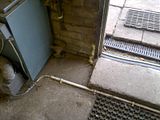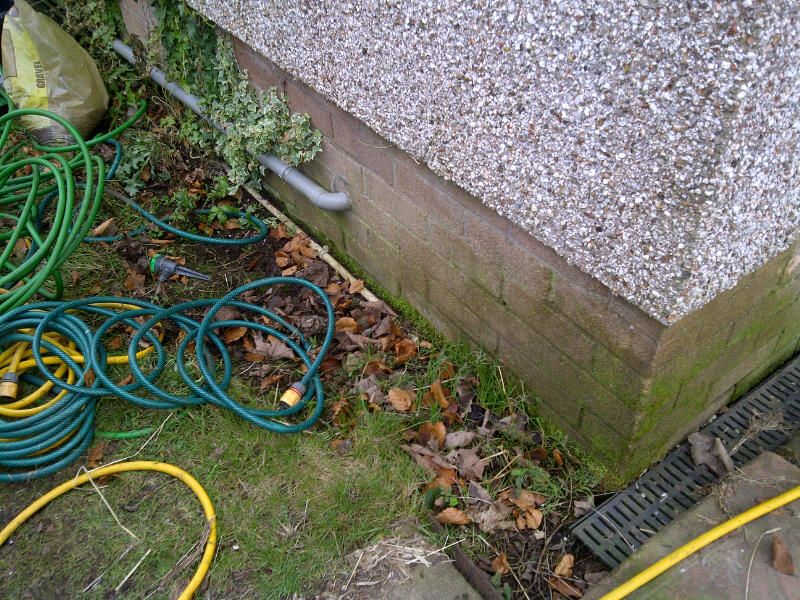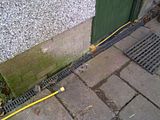![]() You don't need to be an 'investor' to invest in Singletrack: 6 days left: 95% of target - Find out more
You don't need to be an 'investor' to invest in Singletrack: 6 days left: 95% of target - Find out more
I am having a damp problem in my garage. The garage is attached to the house. The house floor sits higher than the garage and there is a sub floor space in the house which we don't have in the garage so the problem is limited to the garage, not the house. We are built on a hill with the ground sloping down from the back to the front so the level is lower at the front. It looks like there is a damp proof course in about three or four bricks up the wall in the garage. The garage has a concrete base. When we get a lot of rain, a regular occurrence water seeps in to the garage through the brickwork. I don't expect I can cure the problem completely but is the best solution just to try to clear some soil etc from around the lower garage walls and put in some drainage with or without some attempt to create a barrier on the outside of the bricks with a membrane? We are always going to get some run off of water from the field behind us so I can't completey stop the water heading in the direction of the garage. On bad days it looks like a river running through it. The whole issue is not helped by the condensation on the asbestos roof but insualtion should cut that back.
Mental image failure. You got any pics of the building?
Have a look at Approved Document Part C for some guidance and background
I'm trying understand if the water is coming from under the suspended ground floor into the garage or from outside into the garage.
Funnily enough I have a very similar situation to the OP. My garage (not attached to the house) sits lower than the neighbours garden and after rain water seeps below the work bench at the end. Only a little, not as bad as the OP. My roof is alu or steel sheeting but again I get condensation on the ceiling that then drops onto the stuff in the garage.
Garage is constructed of 40 year old concrete 'sheets'. Also looking for a solution.
Unsure weather to knock down and start again or what. Following thread with interest.
Here are some photos, I hope.
[img]  [/img]
[/img]
[img]  [/img]
[/img]
[img]  [/img]
[/img]
What I have taken is inside the back door and then outside the back and the side towards the rear. In the first one the water seeps in through the bricks to the side of the boiler doing the same on the other side.
The water is coming in from the rear of the garage so is coming from the outside. Its a lovely field to the back of us, sloping gently up and away to create a nice run off in our direction.
is the damp proof membrane in the first photo above or below outside ground level ?
My street is on a slope, and my neighbours flower beds are higher than the DPC on my garage wall on that side. This gave me a damp wall, but damp was coming in through the floor as well.
My garage is single skin brick work too,
When I had the garage converted into an extra room, I painted the floor and 3 ft up the walls with 3 coats of Aquapruf, then a damp proof membrane and then insulation behind foil backed plaster board walls / floating floor.
No damp now!
Looks like you could try digging a trench and filling with shingle by your hose pipe collection there too.
The damp proof in the first photo is above the external ground level.
The shingle would help it all drain a bit better I think but should I do anything to try to make the wall a bit more waterproof like Jeff did?
you could fix it completely by [url= http://www.mandamasticasphalt.com/mastic-asphalt-tanking-contractors.html ]asphalt tanking[/url] your garage.
Sharkbait,
That looks like it would be just the job. I guess if they don't operate nationwide there would be somebody similar more local. If it isn't horrifically expensive it might be worth it if it totally deals with it rather than just reducing the problem.
Okay my thoughts are:
What is the siutation with the drainage channel? I also note that it doesn't have an end cap / stop end and that the damp issue is related to this corner of the garage. Does it have a drain connection?
Are you effectively collecting water run off and discharging it to the corner of the garage hence the saturation at the corner?
Top photo is a little small to make out what is going on.
You can buy floor / wall sealant (asphalt, bitumen or latex based) from a builder's merchant and paint it on yourself.
pjm,
The drainage is as it was when we moved in a year ago and is pretty much a token effort I think, done by somebody even worse at DIY than me. It doesn't really have anywhere to go.
Maybe an attempt at a DIY solution with improved, not that that would be difficult, drainage combined with floor/wall sealant would do the trick or at least enough to be happy with.
Per pjm - that threshold drain doesn't look like it's achieving anything. It's purpose is to collect run off which then drains into the rainwater system. If that's connected in as described and just needs capped off / cleaned out then you'll partially solve your problem fairly easily.
Also the moss will be acting as a bridge over your dpc so you want to take a wire brush to that for starters.
However, your garage slab appears to be c 50mm below the level outside so seems to me you have to intercept the water before it reaches the external wall and or tank it.
I think you are right about the existing drain. At the moment it is just decoration.
The slab does sit below the outside ground height. I think the consensus seems to be some sort of physical barrier between the water and the interior which seems logical.
Will sort the moss. That's an easy one although not really my main problem but it all helps.
cu dubh: No idea of the cost but it is extremely effective as it creates a thick solid barrier which water cannot pass through. Yes there will be someone near you also.
We had our old house done like this as the kitchen was actually hewn out of the bedrock.
My current offices (ex-double garage) also have asphalt floors and are completely dry.
If you do it DIY and use Aquapruf or similar, then you will need a plan for what you are going to cover it with e.g. floating floor / battens + plasterboard. It's sticky stuff and it stays a bit sticky 🙂